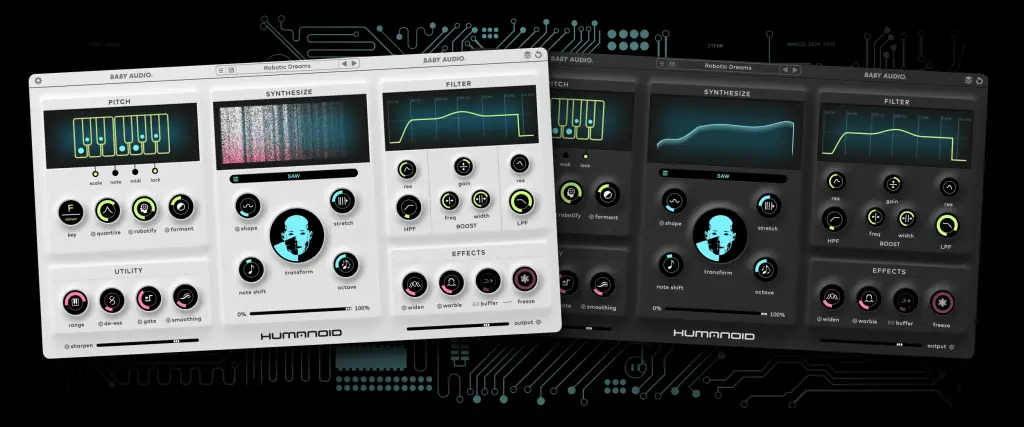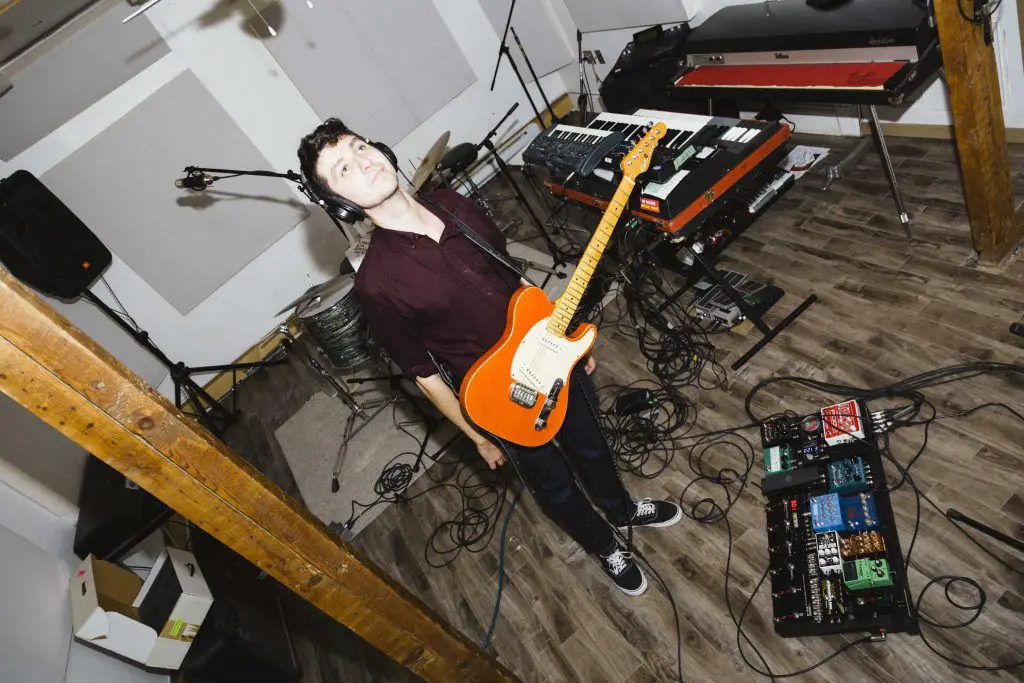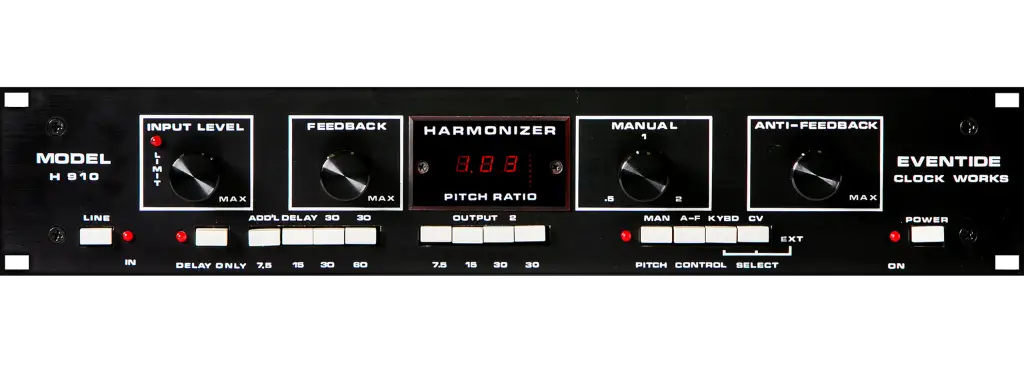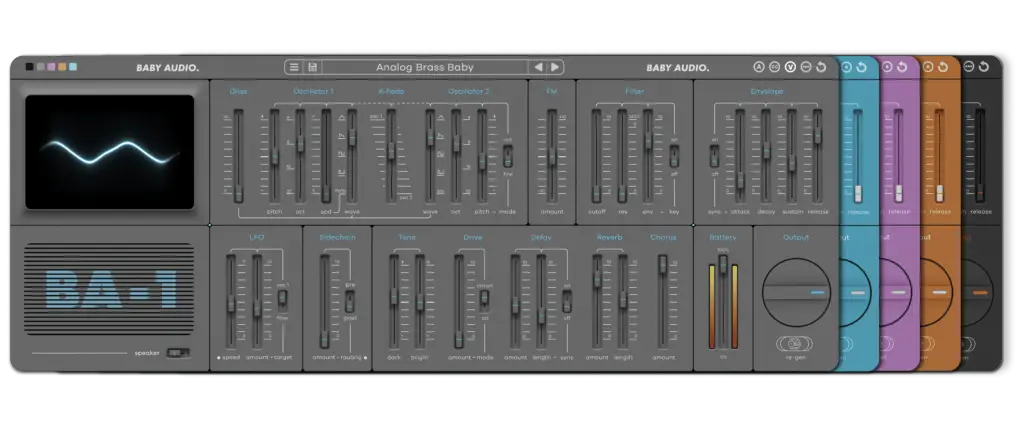Table of Contents
It’s no secret that we humans love the sounds of our voice. Well, we usually don’t like hearing the sounds of our own voices personally, but the human race gravitates toward human vocals. It’s why you don’t need to look that far into any of the charts, top-performing songs, or anything over the past five decades or more, and you’ll be hard-pressed to find many exclusive instrumental track.
And as AI and all these other buzzwords, plugins, and studio tools make recording professional-quality vocals easier, that also raises the bar for how exciting and creative vocals need to be. So, being able to creatively manipulate vocals in ways that go beyond just clean, polished, radio-ready mixes is becoming paramount for an artist’s success and for the overall perceived quality of the song.
In this article, we chatted with the experts over at Baby Audio, who recently released a plugin, Humanoid.
What We’re Talking About Here
What Is Baby Audio’s Humanoid?

Humanoid is a Swiss Army Knife-level tool that helps you manipulate, chop, screw, effect, gate, and apply all sorts of effects to really get the most out of the vocals that you record or the vocal samples that you want to use in your own tracks. We picked their brains about the most commonly asked questions about vocal manipulation and creative uses for vocals in a track, using and leaning heavily on the technology of their latest Humanoid plugin.
With the current intro sale, you can save 40% off the regular price of $129 and get it for only $79. Humanoid is designed to produce stunningly robotic vocals from any singing performance. It’s an over-the-top pitch corrector that offers instant hard-tuning and radical voice manipulation.
Humanoid takes vocal tuning to new extremes. If you’re aiming for natural vocals, this isn’t the plugin for you. You can morph your vocals into synth waveforms, creating unique timbres that merge human and machine qualities.
Choose from 64 factory wavetables or import your own for endless sonic variation. Humanoid allows you to create harmonies from any vocal take, turning a lead vocal into a symphony or using it as a futuristic vocoder. With 180 presets crafted by leading sound designers, Humanoid offers new timbres and variations for good singers and a total makeover for those less skilled.
So, without further adieu, let’s dive into the interview with Michael Hahn of Baby Audio and figure out everything that’s been on my mind and, I bet, on your mind too, about vocal manipulation in music production.
Who Is Michael Hahn?

Michael Hahn is a Montreal-based musician, audio engineer, and music writer. In addition to serving as the senior engineer at Autoland Audio, the studio he founded in Montreal’s Mile Ex neighborhood, Michael was a staff writer and managing editor at the LANDR Blog before joining Baby Audio this year. He’s here today acting as the product specialist for BA’s latest release, Humanoid. Launched at the end of June, Humanoid is a vocal processor combining new approaches to pitch correction and vocal resynthesis with powerful effects and voice-transforming tools.
We sat down to talk all things vocal production and how Humanoid can expand the possibilities for creative producers to shape their vocal tracks.
Vocal Production Interview
What are your favorite techniques for manipulating vocal tracks in music production?

Vocals are such an important part of any production, and they’re hugely meaningful to artists as part of their self-expression.
For me as a producer, vocal processing has to follow the direction of the song and the persona the artist is trying to bring to life with their singing. But when an artist is willing to experiment with vocals, they are a tremendous blank canvas for creative processing.
There are classic techniques that I’ll never get tired of, like double tracking for certain singers and voice types, but it’s great to go further when the artist is up for it. Stereo widening using something like the BA-1 FX strip’s analog-style chorus is definitely a go-to for me. A little bit of dimension can really help get a loud vocal to feel right in the mix for certain styles.
We added an analog-style chorus to Humanoid because it just felt like a natural extension of how you would want to process a really stylized vocal sound.
How do you unconventionally incorporate delays and reverbs to enhance vocals?

Delay and reverb are kind of the foundation for vocal effects and it’s always interesting for me because what I think will work at first isn’t always the right solution for the mix when I get to the end.
I often can’t decide if I want a super wide stereo vocal reverb or a really mono and directional one, and it often takes a bit of experimentation to find out.
That’s why I love the width control on Crystalline because I can really dial that in. Some settings can be incredibly wide and enveloping but it can just as easily be set to sound direct and beamy. Both extremes are quite usable and musical, which is amazing to get in one plugin. It’s subtle, but panning a narrow vocal reverb somewhere in the stereo field and adding a bit of analog saturation from something like TAIP can do more to situate the sound in a space than a hyper realistic convolution reverb for me sometimes..
You have to remember that mixing isn’t really about creating something that mimics real life—it’s easy to get caught up in that perspective at times!
Can you discuss using harmonizers and their effect on vocal texture?

Harmonizers have been one of these mindblowing technologies since the early days of DSP.
You just get the sense that it was a pain for producers to constantly overdub double tracks and harmonies and that a lot of effort went into making them perfect during that era.
Things like the original Eventide Harmonizer units were imagined as a solution to some of that manual effort, but of course they had their own sound that became classic in its own right. But just having these tools got people experimenting with pitch manipulation and formant shifting and it hatched a whole lineage of technologies.
Humanoid is part of that in a way, but its tech innovations put it in its own category.
You can remap vocal pitch to create harmonies or play it with MIDI in vocoder-style, but it sounds quite different from classic harmonizers or vocoders. In terms of the texture, since the incoming vocal signal remains the source of the sound, it’s much different than a vocoder where the carrier and modulator signals interact and you have to try different carriers to get it to sound right.
On other hand, it’s really different from a harmonizer in the sense that shifting the pitch further away from the original doesn’t introduce more artifacts as you go.
It’s sort of like the most articulate vocoder you’ll ever hear, or the cleanest pitch shifting harmonizer—but has its own sound that it brings to the table. A bit hard to describe, you just have to try it.
What are some innovative ways to use reverb and delay in reverse for vocal manipulation?

I love reverse audio because it poses such interesting questions about sound perception.
The waveform you hear is the same—you just experience it in the opposite direction. There’s so much wrapped up in why that sounds uncanny to our ears.
Add spatialization cues like reverb and delay and it can get truly psychedelic in the way it distorts your perception. Reverse reverb is a favorite for me because of how it was implemented on certain classic units like the Yamaha SPX series. Those are sort of infamous at this point for being used for the ‘glide guitar’ textures on Loveless by My Bloody Valentine and so on.
At BA we’ve always loved those imperfect methods that were used in the early days to get around the limitations of the hardware at the time. The reverbs we implemented in BA-1 (as well as its companion FX Strip) and SuperVHS pay a bit of homage to those early techniques.
In reverse, the vintage style is unmistakable and I usually prefer it to more pristine modern reverse reverbs.
Of course, the next step is realizing that reverse reverb is just one of many ways to create ‘nonlinear’ decay profiles, but that’s a whole other story. There’s really a lot to explore with it.
How do you balance using experimental vocal techniques with maintaining clarity and intelligibility in the mix?
Clarity and intelligibility need to be available at every step of the process.
Listeners need the lyrics as an entry point to the drama of the song, so anything that obscures them too much is out of bounds in my opinion. That’s why so many vocal processors and mixing chains emphasize parallel processing, from dynamics to ambience.
You need to be able to get clarity back when you need it and make sure that any decisions that contribute to the style can still shine while delivering the lyrics with impact.
Humanoid has a number of blending options and a really powerful EQ and filter to make sure that you never have to sacrifice intelligibility when you’re working with a highly processed vocal. I usually keep the Transform control a bit lower so the resynthesis waveforms are more subtle. I also like to blend back a little of the pitch engine on its own with the blend slider. If that still isn’t enough, there’s a global wet/dry blend for the whole plugin that can bring the original source material back into the signal.
I’ve done that a few times and been shocked by the transformation to the vocal after manipulating it with Humanoid—it’s that powerful!
Humanoid is out now, available direct from Baby Audio at babyaud.io. It’s on intro sale for a limited time at $79 down from $129 for 40% off. Free Trial available.
The post How To Manipulate Vocals In Music Production: Baby Audio’s Team Shares 5 Ways To Make The Most Of The Human Voice appeared first on Magnetic Magazine.



